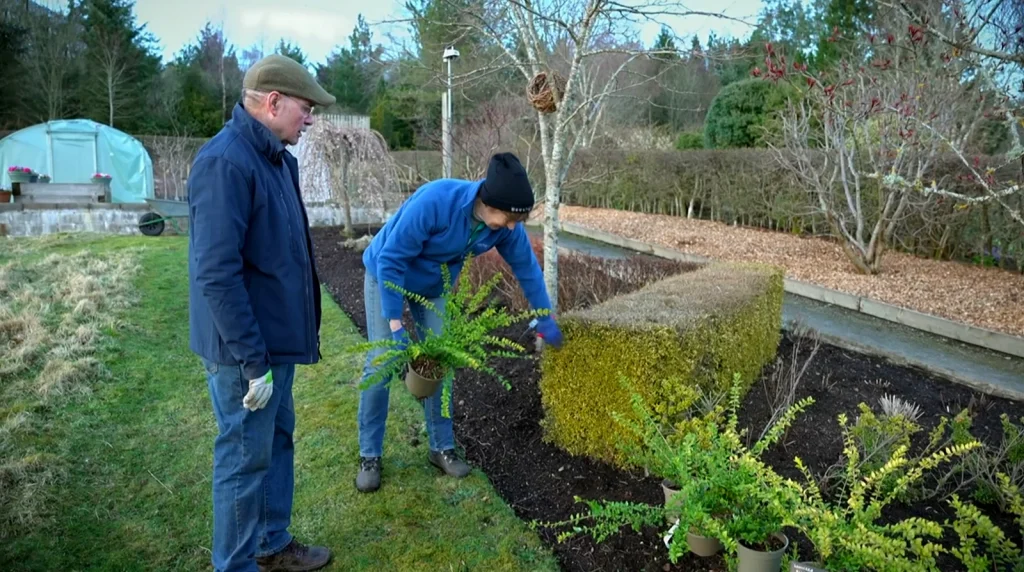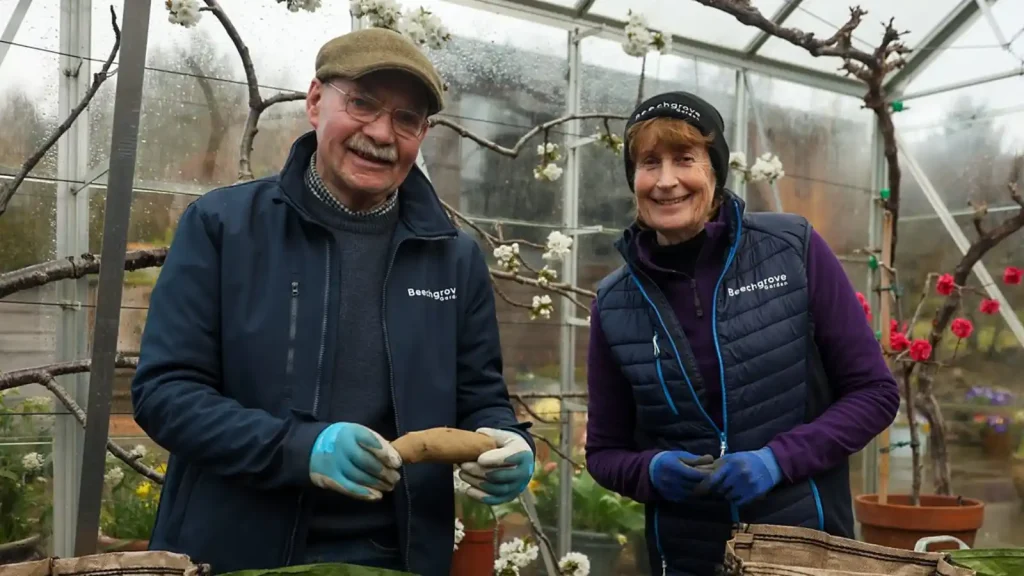In The Beechgrove Garden 2024 episode 14, the expert gardening team provides insightful tips and innovative ideas for gardening enthusiasts who may be limited by space but still wish to enjoy the aromatic delights of a herb garden. This episode features Lizzie Schofield, who has taken the lead in developing the program’s herb garden throughout the year.
She offers valuable guidance on cultivating herbs in small spaces, focusing particularly on methods suitable for container and window box gardening. Lizzie discusses the selection of herbs that thrive in confined areas, making it easy for viewers who may not have expansive gardens to still grow a variety of flavorful and fragrant herbs.
Adding to the educational content, Ruth Vichos, a respected horticultural lecturer, joins the Beechgrove team. Ruth demonstrates a cost-effective technique to enhance your plant collection—softwood cuttings. This method allows gardeners to propagate new plants from their existing ones without any expense. Her segment is particularly geared towards helping viewers understand the step-by-step process of taking cuttings, ensuring successful growth and cultivation.
Moreover, the episode includes practical advice on the sustainable use of garden waste. The team shares a creative approach to utilizing grass cuttings that not only recycles garden waste but also benefits the garden ecosystem. Additionally, Ruth discusses the importance of sowing biennials that are beneficial for pollinators. She explains which plants are best for attracting and supporting pollinators, which play a crucial role in the health of any garden.
The Beechgrove Garden’s latest episode is packed with expert advice, practical tips, and sustainable gardening practices that are essential for anyone looking to make the most out of their garden space, regardless of its size. Whether you’re a seasoned gardener or just starting out, the insights from Lizzie and Ruth provide invaluable resources for growing a thriving, biodiverse garden that supports local wildlife and brings the beauty of nature right to your doorstep.
The Beechgrove Garden 2024 episode 14
The Allure and Ease of a Miniature Herb Garden
In the heart of every kitchen, a symphony of flavors awaits. Imagine plucking a sprig of fragrant basil, its peppery aroma filling the air as you add it to your simmering tomato sauce. Picture the delicate, citrusy zest of lemon thyme elevating your roasted chicken. Envision the soothing scent of lavender infusing your evening tea, calming your mind and body.
These aren’t scenes from a culinary magazine, but possibilities waiting to be unlocked in your own home. With a miniature herb garden, you can transform your culinary creations, enhance your well-being, and infuse your living space with natural beauty. And the best part? It’s surprisingly simple to cultivate this aromatic oasis, even if you have limited space.
Whether you have a sprawling backyard or a cozy apartment balcony, a miniature herb garden is within reach. Picture a vibrant collection of herbs flourishing in pots, window boxes, or even repurposed containers. Not only will it provide you with a readily available source of fresh, flavorful ingredients, but it will also add a touch of green elegance to your surroundings.
Imagine stepping outside to harvest a handful of mint for your morning smoothie or snipping a few sprigs of rosemary to infuse your olive oil. Picture yourself brewing a cup of tea with chamomile you grew yourself, its gentle floral notes offering a moment of tranquility.
Beyond their culinary and therapeutic benefits, herbs offer a gateway to the joys of gardening. As you nurture your miniature garden, you’ll witness the magic of seeds sprouting, leaves unfurling, and blossoms blooming. You’ll experience the satisfaction of caring for living things and reaping the rewards of your efforts.
So, whether you’re a seasoned gardener or a novice with a green thumb in the making, join us on this fragrant journey as we explore the enchanting world of miniature herb gardens. Discover the secrets to cultivating a thriving collection, even in the most compact of spaces. Learn how to choose the perfect herbs, nurture them with care, and savor the abundance they bring to your life.
Get ready to embark on a sensory adventure where taste, smell, and sight intertwine. Let the allure and ease of a miniature herb garden awaken your senses and inspire you to create a culinary haven right at your fingertips.
Curating Your Compact Herb Collection: Choosing the Perfect Plants
Space-Saving Superstars: Thriving Herbs for Compact Spaces
In the world of herbs, size doesn’t always matter. In fact, some of the most flavorful and aromatic herbs are perfectly content in compact spaces. These space-saving superstars are ideal for container gardening, thriving in pots, window boxes, or even repurposed containers. Let’s explore some of the best compact herb varieties that will make your miniature garden burst with flavor and fragrance.
Chives, with their slender, grass-like leaves and delicate onion flavor, are a must-have for any herb enthusiast. They form neat clumps that won’t take over your garden, making them perfect for small spaces. Thyme, a versatile herb with a variety of flavors depending on the variety, is another excellent choice. Its low-growing habit and woody stems make it a visually appealing addition to any container garden. And let’s not forget stevia, the natural sweetener that packs a punch in a compact package. Its leaves are a treasure trove of sweetness, perfect for those looking to reduce their sugar intake.
Flavorful Favorites: A Symphony of Tastes and Aromas
Each herb in your miniature garden brings a unique flavor profile to the table. Chives, with their subtle oniony notes, are a delightful addition to salads, soups, and egg dishes. They also make a beautiful garnish, adding a touch of elegance to any plate. Thyme, on the other hand, boasts a more robust flavor that ranges from lemony to earthy, depending on the variety. It’s a staple in Mediterranean cuisine, enhancing the taste of roasted meats, vegetables, and even desserts.
Stevia, the natural sweetener, offers a guilt-free way to satisfy your sweet tooth. Its leaves are incredibly sweet, yet they contain no calories or carbohydrates. Use them to sweeten your tea, coffee, or even baked goods. With a little creativity, you can incorporate stevia into a wide range of recipes, adding a touch of sweetness without the added sugar.
Beyond the Basics: Expanding Your Herb Horizons
While chives, thyme, and stevia are excellent starting points, don’t be afraid to venture beyond the basics. Basil, with its sweet, peppery flavor, is a culinary chameleon that complements a wide range of dishes. Parsley, both flat-leaf and curly, adds a fresh, herbaceous note to salads, sauces, and garnishes. Rosemary, with its piney aroma and robust flavor, is a must-have for roasting meats and vegetables. And lavender, with its calming scent and delicate floral flavor, is perfect for teas, desserts, and even savory dishes.
By expanding your herb collection, you’ll open up a world of culinary possibilities. You’ll have a diverse array of flavors and aromas at your fingertips, ready to elevate your cooking to new heights. So, don’t hesitate to experiment with different herbs and discover new favorites that will make your miniature garden a true culinary haven.
Avoiding Space Hogs: Choosing Herbs Wisely
While we celebrate the virtues of compact herbs, it’s important to be mindful of those that tend to outgrow their welcome. Some herbs, like mint, have a tendency to spread rapidly, quickly taking over a small space. Others, like dill and fennel, can grow quite tall, casting shade on their smaller neighbors.
By carefully selecting your herbs, you can ensure that your miniature garden remains manageable and visually appealing. Opt for varieties that are known for their compact growth habits and avoid those that are prone to sprawling or becoming invasive. With a little planning, you can create a harmonious herb haven where every plant has room to thrive.
Nurturing Your Miniature Oasis: Essential Tips for Thriving Herbs
Container Gardening 101: Laying the Groundwork for Success
Embarking on your miniature herb gardening journey begins with choosing the right containers. Imagine them as cozy homes for your herbs, providing the space and support they need to flourish. Opt for containers with drainage holes to prevent waterlogging, which can suffocate the roots. Additionally, ensure the containers have sufficient depth, allowing the roots to stretch and grow. Remember, different herbs have different space requirements, so choose container sizes accordingly. For instance, perennials like rosemary and lavender prefer larger pots, while compact herbs like thyme and chives can thrive in smaller ones.
But choosing the right containers is just the first step. Filling them with a well-draining potting mix is equally important. Think of it as providing your herbs with a nutritious bed to sleep in. A good potting mix allows for proper aeration and drainage, preventing the roots from becoming waterlogged. You can even enhance the drainage by adding perlite or grit to the mix. Remember, a happy root system translates to a happy herb plant.
Sunlight Savvy: Illuminating Your Herb Haven
Just like us, herbs crave sunlight to thrive. It’s their life force, fueling their growth and enhancing their flavor. Aim to provide your miniature herb garden with at least 6-8 hours of direct sunlight per day. If you have a sunny windowsill or balcony, that’s perfect! But even if you don’t, there are creative solutions to ensure your herbs get their daily dose of sunshine.
Consider using grow lights to supplement natural light, especially during the winter months when daylight hours are shorter. You can also rotate your herbs, giving each plant a turn to bask in the sun’s rays. Remember, a little sunlight goes a long way in ensuring your herbs reach their full potential.
Watering Wisdom: Quenching Thirst Without Drowning
Watering your herbs might seem straightforward, but it’s an art that requires finesse. Overwatering can lead to root rot, while underwatering can leave your herbs parched and wilted. So, how do you strike the right balance? The key is to water deeply but infrequently, allowing the soil to dry out slightly between waterings.
Stick your finger into the soil to gauge its moisture level. If it feels dry to the touch, it’s time to water. If it feels moist, hold off for a bit longer. Remember, different herbs have different water needs. For example, Mediterranean herbs like rosemary and thyme prefer drier conditions, while basil and mint enjoy slightly moist soil. Pay attention to the specific needs of each herb and adjust your watering accordingly.
FAQs The Beechgrove Garden 2024 episode 14
Can I grow herbs indoors if I don’t have outdoor space?
Absolutely! In fact, many herbs thrive indoors, making them perfect for those with limited outdoor space or those who live in colder climates. With proper care and attention, you can easily cultivate a thriving indoor herb garden that will supply you with fresh flavors all year round. Herbs like basil, parsley, chives, and mint are particularly well-suited for indoor growing.
To create a successful indoor herb garden, ensure your herbs receive adequate sunlight, either by placing them near a sunny window or supplementing with grow lights. Use well-draining pots and a high-quality potting mix. Remember to water regularly, but avoid overwatering, as this can lead to root rot.
What are the easiest herbs to grow for beginners?
If you’re new to herb gardening, certain varieties are known for their resilience and ease of care. Mint, chives, basil, parsley, and rosemary are all beginner-friendly options. These herbs are relatively low-maintenance and can tolerate a wider range of growing conditions compared to more delicate varieties.
Starting with these easy-to-grow herbs will allow you to gain confidence and experience in herb gardening. As you become more comfortable, you can then expand your repertoire and experiment with other herbs that might require a bit more attention.
How often should I water my herbs in containers?
The frequency of watering will depend on several factors, including the type of herb, the size of the container, the temperature, and the humidity. In general, it’s best to water your herbs when the top inch of soil feels dry to the touch.
However, overwatering is a common mistake that can harm your herbs. To avoid this, ensure your containers have proper drainage and use a well-draining potting mix. Additionally, be sure to empty any saucers under your pots to prevent water from accumulating.
What are some creative ways to incorporate fresh herbs into my cooking?
The culinary possibilities with fresh herbs are endless! Beyond adding them to your favorite recipes, you can infuse oils and vinegars with herbs like rosemary or basil. You can also create herb butters by blending softened butter with chopped herbs like chives, parsley, or thyme.
Fresh herbs can elevate even the simplest dishes. Sprinkle chopped basil on your pizza, add a sprig of thyme to your roasted chicken, or toss a handful of parsley into your salad. Don’t be afraid to experiment and discover new ways to incorporate these flavorful additions into your culinary creations.
Can I grow herbs from seeds or should I buy seedlings?
Both options are viable, and the choice depends on your personal preference and experience level. Growing herbs from seeds can be a rewarding experience, but it requires patience and attention to detail. Seeds need to be sown at the right depth and kept consistently moist until they germinate.
If you’re a beginner, starting with seedlings might be a better option. Seedlings are already established plants, giving you a head start in your herb gardening journey. However, be sure to choose healthy seedlings with vibrant foliage and no signs of pests or diseases.
Savor the Rewards of Your Miniature Herb Garden
A Culinary Adventure Awaits: Unleashing Flavor with Homegrown Herbs
Your miniature herb garden is not just a feast for the eyes; it’s a culinary playground waiting to be explored. With a snip of your scissors, you unlock a world of flavors that will elevate your dishes from ordinary to extraordinary. Imagine the vibrant aroma of freshly chopped basil infusing your homemade pesto or the delicate fragrance of lavender enhancing your baked goods.
However, the possibilities extend far beyond the familiar. Dare to experiment with unexpected combinations, like muddling mint with lime for a refreshing mojito or adding a sprig of rosemary to your grilled steak for a smoky, herbaceous twist. As you explore the diverse flavors of your homegrown herbs, you’ll discover a newfound passion for cooking and a deeper appreciation for the nuances of taste.
A Sensory Delight: The Beauty and Fragrance of Your Herb Haven
Beyond their culinary uses, your miniature herb garden is a multi-sensory experience. The vibrant colors of basil, the feathery texture of dill, and the delicate blossoms of lavender create a visual feast that will brighten any space. As you brush against the leaves, a symphony of aromas fills the air, transporting you to a tranquil oasis.
Moreover, the act of tending to your herbs can be a meditative practice, allowing you to connect with nature and find solace in the simple act of nurturing life. As you water, prune, and harvest your herbs, you’ll feel a sense of accomplishment and pride in the fruits of your labor. Your miniature herb garden is not just a collection of plants; it’s a sanctuary for your senses and a source of joy for your soul.
A Sustainable Choice: Nurturing Nature and Reducing Waste
In a world that’s increasingly aware of the importance of sustainability, growing your own herbs is a small but significant step towards a greener lifestyle. By cultivating your own herbs, you reduce your reliance on store-bought produce, which often comes with plastic packaging and a hefty carbon footprint. Additionally, you ensure that your herbs are free of harmful pesticides and chemicals, promoting a healthier diet for yourself and your loved ones.
Embracing the practice of growing your own food empowers you to take control of your health and well-being while contributing to a more sustainable future. It’s a win-win situation that allows you to savor the flavors of your harvest while treading lightly on the planet.
The Gift of Green: Sharing the Joy of Homegrown Herbs
The joy of a miniature herb garden is meant to be shared. As your herbs flourish, consider gifting a potted plant to a friend or neighbor. Imagine the delight on their faces as they receive a living, breathing gift that they can nurture and enjoy. You can also share your harvest with loved ones, inspiring them to embark on their own herb-growing journeys.
By spreading the joy of gardening and the flavors of your harvest, you create a ripple effect of positivity and well-being. You empower others to take control of their food sources, connect with nature, and experience the simple pleasures of growing their own food. And in the process, you cultivate a community of like-minded individuals who share your passion for fresh, flavorful, and sustainable living.




